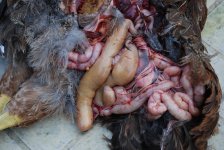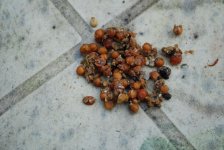dinosaw
New member
- Joined
- Aug 12, 2011
- Messages
- 1,659
- Reaction score
- 0
We had a sudden death of one of our growers during the night last night and found the body in the coop this morning. She had seemed perfectly fine yesterday morning so it was a bit of surprise. On doing an autopsy I found that her lower intestine and ceca were absolutely full of foamy caecaly fluid, her crop was empty and her liver was a bit paler than I would have expected on a 20 week old bird. What surprised me was when I cut open the gizzard, there were around 70 pips in there which I am fairly sure are from hawthorn berries looking at the size and shape of them. Looking into it, it would seem that while the berries themselves are not poisonous, the seeds contain a compound which in humans at least can break down into hydrogen cyanide. Wild birds don't seem to have any problems with the seeds but then they probably dont gorge themselves on about 70 of them either. I am wondering if anyone else either has any thoughts or has experience of their chickens eating hawthorns and falling ill, given the sudden nature and lack of symptoms this is the only thing I can come up with that fits.


